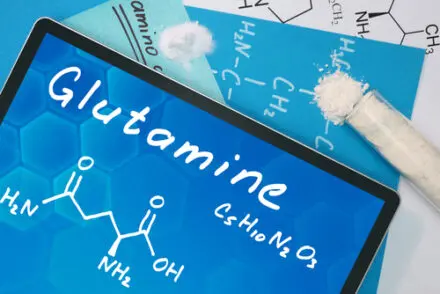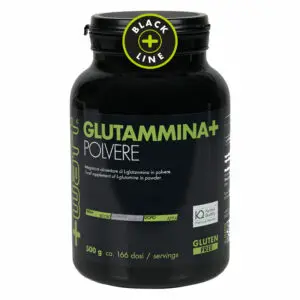Glutamine: the conditionally essential amino acid for athletes
Glutamine is the most abundant free amino acid in the human body and accounts for more than 60% of the free muscle amino acids. It belongs to the group of 21 proteinogenic amino acids, the ones that our body uses to synthesize the proteins which compose it. More specifically, it is defined as a “conditionally essential” amino acid. This definition is linked to the fact that although our organism is able to synthesise it autonomously, in certain physiological situations the synthesized glutamine is not enough to meet the needs of the organism.
A well-known example in which glutamine ‘becomes’ essential is in sports individuals.
This is also due to the fact that our cells use a large amount of glutamine, which is even higher in sports people. Firstly, glutamine is of fundamental importance in skeletal muscle cells where it has been shown to play a role in maintaining muscle proteins (anti-catabolic action), contributing to the maintenance of cellular hydration, acting a glucose/glycogen precursor, and in disposing nitrogenous waste in the form of ammonia, a molecule derived from the catabolism of proteins and potentially toxic to cells.
Glutamine is also the most commonly used source of energy by the cells of the intestinal tract (enterocytes) and is therefore essential to ensure the proper functioning of this organ (de Oliveira et al, Nutrire, 2016). Since the cells of the intestine use a large quantity of glutamine, there is a risk that, if not properly supplied to the body in sufficient quantities, glutamine introduced orally is entirely captured by the intestine, leaving muscle tissue deprived.
There is also another fundamental aspect to take into consideration: glutamine plays a key role in the health of our immune system, that is the set of cells and organs used to defend our body from infections. In particular, glutamine is also used in large quantities by the cells of our immune system (white blood cells or leucocytes) as a source of energy, almost as much as glucose itself (Newsholme, J Nutr, 2001).
It is a well-known fact that the level of glutamine in the blood decreases in athletes after intense and prolonged physical activity, consequently reducing the efficiency of the immune system to cope with infections (Castell et al, Eur J Appl Physiol Occup Physiol, 1996). In fact, while it is widely recognized that moderate physical activity improves resistance to viral and bacterial infections, on the other hand, exercise that exceeds a certain intensity threshold reduces resistance to infections (immunodepressive effect), especially if combined with low-calorie diets or diets that do not adequately meet the needs of the various nutrients.
It is therefore clear that glutamine supplementation supports the normal defences of our white blood cells and significantly reduces the risk of infections. One study compared 150 marathon and ultra-marathon runners, divided into two groups, giving the first group 5 g of glutamine after a marathon and the second group a placebo. The results showed that 7 days after the race, 81% of athletes who took glutamine had no upper respiratory tract infections, while only 49% of those who took placebo did not have any infections (Castell et al, Eur J Appl Physiol Occup Physiol, 1996).
It is therefore clear that glutamine helps and sustains the immune system and can prevent/mitigate infections or decrease the severity of inflammation associated with intense and prolonged exercise. This enables athletes to recover quicker and to train more frequently.
To conclude, it is clear that thanks to all the various activities it carries out in the human body, glutamine can be beneficial for all athletes, from those who perform power sports and require large muscle mass to athletes who face the risk of overtraining.
+Watt Advice
Recommended use: take 3-5 g of glutamine per day.


